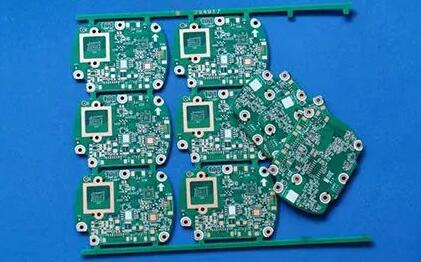Circuit board cutting refers to dividing a circuit board into two or several pieces according to a reasonable circuit without affecting its effectiveness. PCB cutting is usually carried out using a PCB cutting machine.

The method of cutting circuit boards
1. Linear cutting (V-cutting): This is the most common cutting method. By using cutting tools or V-knives, perform straight cuts along the edges of the PCB board or specified cutting lines to achieve the desired size and shape.
2. Milling and cutting: For PCB boards that require more precise shapes and hole positions, CNC milling machines are often used for milling and cutting. According to the design documents, use a rotating tool to remove excess material from the PCB board to achieve the desired shape and size.
3. Wire cutting: Some complex PCB boards may require internal or complex curve cutting. At this point, wire-cutting technology can be used to cut PCB boards along a predetermined path using a high-speed fine wire-cutting machine. Wire cutting can achieve high accuracy and complexity.
4. Laser cutting: Laser cutting is a non-contact cutting technology that can achieve high-precision and complex shape cutting. By utilizing the thermal energy of the laser beam, the material on the PCB board is evaporated or melted, thereby achieving the desired shape cutting.
V-Cut cutting method
V-cut is a set of dividing lines that are pre-cut using a rotary cutting tool at specific positions on the PCB according to the drawing requirements. Its purpose is to facilitate the subsequent assembly of SMT circuit boards for the De panel.
The reason why V-Cut needs to be designed on the circuit board is because the circuit board itself has a certain strength and hardness,
The pre-cut V-Cut circuit facilitates the operator to smoothly cut the original panel into a single board.
Firstly, V-Cut can only cut straight lines, and it can only be cut to the bottom with one cut. That is to say, V-Cut can only be cut into a straight line from head to tail. It cannot turn or change direction, nor can it jump off a small section like a sewing line. This is because the grooves of V-Cut are cut using an electric saw with two discs on top and bottom, and because PCB cutting requires precision (measured in millimeters), it is not possible to operate cutting only half and then retracting the tool.
Secondly, if the PCB thickness is too thin, it is not suitable to make V-Cut grooves. Generally, if the thickness of the board is below 1.0mm, it is not recommended to make V-cut grooves because V-cut grooves will damage the structural strength of the original PCB. When heavy parts are placed on a board with a V-cut design, the board will become easily bent due to gravity, which is very unfavorable for SMT welding operations (easy to cause empty welding or short circuits).
In addition, when the PCB passes through the high temperature of the reflow furnace, the board itself will soften and deform due to the high temperature exceeding the glass transfer temperature (Tg). If the V-Cut position and groove depth are not designed properly, the deformation of the PCB will be more severe, which is not conducive to the secondary reflow process.
Stamp hole connection
Generally, PCBs are V-CUT, and stamp holes may only be used when encountering irregular or circular boards. The boards (or empty boards) are connected by stamp holes to provide support and prevent them from falling apart. If the mold is opened, it will not collapse. The most common way is to use them to create PCB-independent modules, such as Wi-Fi, Bluetooth, or core board modules, and then use them as independent components placed on another board during the PCB assembly process.
V-cutting is mainly used to divide entire PCB boards to improve efficiency and reduce costs in mass production.